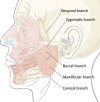Facial nerve trauma: evaluation and considerations in management
- PMID: 25709748
- PMCID: PMC4329040
- DOI: 10.1055/s-0034-1372522
Facial nerve trauma: evaluation and considerations in management
Abstract
The management of facial paralysis continues to evolve. Understanding the facial nerve anatomy and the different methods of evaluating the degree of facial nerve injury are crucial for successful management. When the facial nerve is transected, direct coaptation leads to the best outcome, followed by interpositional nerve grafting. In cases where motor end plates are still intact but a primary repair or graft is not feasible, a nerve transfer should be employed. When complete muscle atrophy has occurred, regional muscle transfer or free flap reconstruction is an option. When dynamic reanimation cannot be undertaken, static procedures offer some benefit. Adjunctive tools such as botulinum toxin injection and biofeedback can be helpful. Several new treatment modalities lie on the horizon which hold potential to alter the current treatment algorithm.
Keywords: facial nerve injury; facial paralysis rehabilitation; facial reanimation; facial sling; free tissue transfer; hypoglossal-facial nerve transfer; intratemporal facial nerve trauma; temporalis tendon transposition.
Figures






Similar articles
-
Transposition of the Intratemporal Facial to Hypoglossal Nerve for Reanimation of the Paralyzed Face: The VII to XII TranspositionTechnique.JAMA Facial Plast Surg. 2016 Sep 1;18(5):370-8. doi: 10.1001/jamafacial.2016.0514. JAMA Facial Plast Surg. 2016. PMID: 27348018
-
Facial reanimation using hypoglossal-facial neurorrhaphy with end-to-side coaptation between the jump interpositional nerve graft and hypoglossal nerve: Outcome and duration of preoperative paralysis.Microsurgery. 2016 Sep;36(6):460-6. doi: 10.1002/micr.22393. Epub 2015 Aug 28. Microsurgery. 2016. PMID: 26316293
-
Temporalis Muscle Transfer with Fascia Lata Sling: A Novel Technique for Facial Reanimation.Ann Maxillofac Surg. 2018 Jul-Dec;8(2):307-310. doi: 10.4103/ams.ams_214_18. Ann Maxillofac Surg. 2018. PMID: 30693251 Free PMC article.
-
Reanimation of the paralyzed face.Otolaryngol Clin North Am. 1992 Jun;25(3):649-67. Otolaryngol Clin North Am. 1992. PMID: 1625868 Review.
-
Advances in facial reanimation.Curr Opin Otolaryngol Head Neck Surg. 2006 Aug;14(4):242-8. doi: 10.1097/01.moo.0000233594.84175.a0. Curr Opin Otolaryngol Head Neck Surg. 2006. PMID: 16832180 Review.
Cited by
-
Post Temporal Bone Fracture Facial Paralysis: Strategies in Decision Making and Analysis of Efficacy of Surgical Treatment.Indian J Otolaryngol Head Neck Surg. 2018 Dec;70(4):566-571. doi: 10.1007/s12070-018-1371-y. Epub 2018 Apr 19. Indian J Otolaryngol Head Neck Surg. 2018. PMID: 30464917 Free PMC article.
-
Anatomical knowledge of zygomatico-buccal plexus in a cadaveric study.Anat Cell Biol. 2023 Sep 30;56(3):313-321. doi: 10.5115/acb.23.040. Epub 2023 Apr 18. Anat Cell Biol. 2023. PMID: 37070431 Free PMC article.
-
Molecular and Cellular Modelling of Salivary Gland Tumors Open New Landscapes in Diagnosis and Treatment.Cancers (Basel). 2020 Oct 24;12(11):3107. doi: 10.3390/cancers12113107. Cancers (Basel). 2020. PMID: 33114321 Free PMC article. Review.
-
Frequency of Peripheral Nerve Injury in Trauma in Emergency Settings.Cureus. 2021 Mar 30;13(3):e14195. doi: 10.7759/cureus.14195. Cureus. 2021. PMID: 33948395 Free PMC article.
-
Nonmicrosurgical Grafting for Facial Nerve Branches with Permanent Sensational Functional Outcome.Plast Reconstr Surg Glob Open. 2019 May 16;7(5):e2195. doi: 10.1097/GOX.0000000000002195. eCollection 2019 May. Plast Reconstr Surg Glob Open. 2019. PMID: 31333934 Free PMC article.
References
-
- May M. New York, NY: Thieme Medical Publishers; 2000. Anatomy for the clinician; pp. 19–56.
-
- Bernstein L, Nelson R. Surgical anatomy of the extraparotid distribution of the facial nerve. Arch Otolaryngol. 1984;110:177–183. - PubMed
-
- Tate J, Tollefson T. Advances in facial reanimation. Curr Opin Otolaryngol Head Neck Surg. 2006;14:242–248. - PubMed
-
- Bergeron C, Moe K. The evaluation and treatment of upper eyelid paralysis. Facial Plast Surg. 2008;24(2):220–230. - PubMed
-
- Meltzer N E, Alam D S. Facial paralysis rehabilitation: state of the art. Curr Opin Otolaryngol Head Neck Surg. 2010;18(4):232–237. - PubMed
Publication types
LinkOut - more resources
Full Text Sources
Other Literature Sources
